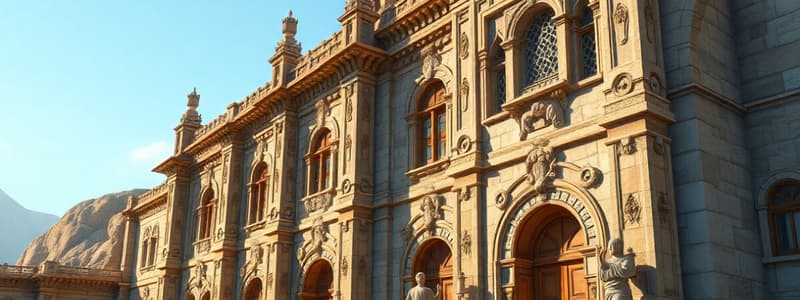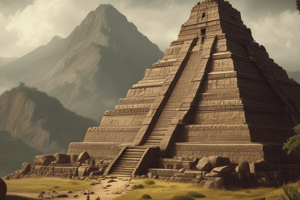Podcast
Questions and Answers
What is the longest mountain chain in the world?
What is the longest mountain chain in the world?
- Andean mountain range (correct)
- Himalayas
- Alps
- Rocky Mountains
What material is predominantly used in Inka architecture?
What material is predominantly used in Inka architecture?
stone
The Inka used mortar to hold their stone constructions together.
The Inka used mortar to hold their stone constructions together.
False (B)
What is the name of the Inka road network?
What is the name of the Inka road network?
The Inka preferred very fine grained stones for their masonry because large mineral inclusions made cutting difficult. They sought out dense hard stones, such as _______ and harder limestones.
The Inka preferred very fine grained stones for their masonry because large mineral inclusions made cutting difficult. They sought out dense hard stones, such as _______ and harder limestones.
What is the major difference between polygonal and ashlar blocks in Inka masonry?
What is the major difference between polygonal and ashlar blocks in Inka masonry?
What sacred significance do stones hold in Andean culture?
What sacred significance do stones hold in Andean culture?
Match the following Andean sites with their significance:
Match the following Andean sites with their significance:
What material did the builders of Tiwanaku prefer for their finest work?
What material did the builders of Tiwanaku prefer for their finest work?
Tiwanaku masons had access to hard metal tools for their carvings.
Tiwanaku masons had access to hard metal tools for their carvings.
Which of the following were part of the Tiwanaku toolkit?
Which of the following were part of the Tiwanaku toolkit?
What was the main architectural form used by the Inka?
What was the main architectural form used by the Inka?
What were some key design elements of Inka architecture?
What were some key design elements of Inka architecture?
What role did textiles play in Inka architecture?
What role did textiles play in Inka architecture?
Match the Inka structure with its function:
Match the Inka structure with its function:
Most elite sites in Inka architecture were constructed with quality stone.
Most elite sites in Inka architecture were constructed with quality stone.
What was the purpose of an usnu in Inka cities?
What was the purpose of an usnu in Inka cities?
The Inka called a house for drying clothes a _____ uasi.
The Inka called a house for drying clothes a _____ uasi.
What is the symbolic significance of the design of Inka architecture?
What is the symbolic significance of the design of Inka architecture?
What material did the Inka primarily use in their architecture that was considered sacred?
What material did the Inka primarily use in their architecture that was considered sacred?
What engineering skills did the Inka require to build on the Andean landscape?
What engineering skills did the Inka require to build on the Andean landscape?
Inka architecture was entirely uniform across all their sites.
Inka architecture was entirely uniform across all their sites.
What were some distinguishing features of Inka architecture?
What were some distinguishing features of Inka architecture?
What traditional Andean architectural form did Tiwanaku develop?
What traditional Andean architectural form did Tiwanaku develop?
The Inka built their structures primarily using __________ materials.
The Inka built their structures primarily using __________ materials.
What is a key reason the study of Andean architecture is still developing?
What is a key reason the study of Andean architecture is still developing?
All aspects of Inka architecture have been thoroughly researched.
All aspects of Inka architecture have been thoroughly researched.
Flashcards are hidden until you start studying
Study Notes
Inka Architecture
- Inka architecture is closely related to the Andean mountains, known for their diversity of ecosystems.
- Inka architecture is characterized by its mastery of stone masonry, particularly using granite.
- Inka stone masons preferred fine-grained, dense, hard stones like andesite and harder limestones.
- They used hammerstones to rough shape blocks before transport.
- Inka roads, part of a vast network called the Capac Ñan, were used to transport materials and control movement.
- Stones were transported using ropes and ramps to aid in gravity-assisted movement.
- Inka stonemasons carved stones with precision, ensuring a perfect fit in walls.
- They used a variety of hammerstones, including rounded river cobbles to carve stones with increasing delicacy.
- The hammerstone process left distinct pit scars on the stone surfaces, revealing the tools used.
- Inka walls were composed of polygonal or ashlar blocks, with polygonal blocks being easier to carve.
- Inka considered stone a sacred material, connecting it to the earth mother (Pachamama) and sacred places (huaca).
- Inka architecture blended the natural and manmade, blurring the lines between sacred outcrops and carved stone blocks.
Andean Stone Carving Traditions
- Andean stone carving traditions predate the Inka, with sites like Chavín de Huántar and Tiwanaku showcasing exceptional stone mastery.
- Chavín de Huántar, a pilgrimage site, featured granite ceremonial structures, tunnels, and stone tennon heads depicting transformation.
- Tiwanaku, near Lake Titicaca, is known for its monumental civic structures and Puma Punku complex, which showcases some of the finest stone carving in the world.
- Tiwanaku masons used hard, fine-grained andesite to create perfectly planar surfaces, exact right angles and sharp edges.
- Tiwanaku masons employed a diverse toolkit that might have consisted entirely of stone tools.
- The meticulous nature of stone carving in Andean traditions, known as "facture," emphasized the value of the making process.
Stone Architecture in the Andes
- Stone was a highly important material in Andean architecture, particularly for the Inka
- The Inka developed a style of stonework that was deceptively easy to create and built upon their skilled workforce
- This style of stonework was simple to teach to unskilled laborers and required a small toolkit
- Stone masons called "pircacamayoc" worked year-round for the state
- The stonework of the Inka is similar in design to the Chavín and Tiwanaku stonework, however, it was simpler to make
- Inka stonework used ashlar and polygonal techniques and was used in the construction of many buildings
Inka Architecture
- The Inka developed a unique architectural vocabulary, based on seven core elements
- These elements were:
- Single-room, rectangular buildings
- Battered walls
- Trapezoidal features (doors, windows, and niches)
- Gabled and hipped roofs
- Terraces
- Relationship to natural features
- Stone architecture, such as polygonal and ashlar masonry
- The Inka used these elements in combination to create a distinctive architectural style
- The combination of these elements allowed the Inka to build diverse sites rapidly and efficiently
- Inka architecture was highly adaptable to the environment and the needs of the Inka empire
Inka Building Types
- The most common building type for the Inka was a rectangle, which could be varied in size, proportion and openings
- The Inka had a range of names for their buildings, which provide insights into how they gave value and meaning to their buildings
- Some of these names include:
- Suntur Uasi: Tower (usually round but could also be square or rectangular in plan)
- Colca: A building or collection of buildings used for storage
- Churacona Uasi: A type of storage consisting of interconnected squares
- Marca Uasi: A type of storage structure with a loft
- Pata: A step or staircase
- Pampa: An open space, usually associated with ceremony or performance
Inka Architectural Terminology
- Usnu: Viewing platform where the Inka or his representative would stand
- Kallanka: A rectangular block used for foundations, often made of ashlar masonry
- Kallanka Uasi: A structure built of kallanka blocks
Relationship Between Architecture and Landscape
- The Inka believed the landscape was sacred, particularly materials such as stone
- The Inka used architecture to articulate this understanding
- The Inka also used stone in architecture to symbolize their entanglement with sacred status and power
Inka Architecture in the Context of the Andes
- Inka architecture was highly adaptive and flexible to the needs of a rapidly expanding imperial state
- The Inka often adapted local design and construction elements to create a unique architectural style
- Inka architecture was a reflection of the Inka state and its imperial agenda
- Inka architecture also reflected local cultural dynamics and history
- Inka stone architecture served as a visible symbol of elite Inka status and presence
- The Inka legacy in architecture lives on in the Andes today.
The Role of Materials in Andean Architecture
- Materials were important in Andean architecture with stone being a particularly important material
- Chavín de Huántar master masons used stone to create a majestic monument and depict sacred images
- Tiwanaku developed a technology and process for stone carving that was equal to some of the finest stone carving ever created
- The Tiwanaku viewed the process of making stone objects as sacred
Inka Architecture and its Influences
- The Inka architectural achievements were inspired by the Chavín and Tiwanaku
- The Inka developed a unique architectural style that was influenced by these earlier cultures, but also reflected their own culture and needs.
Inca Architecture
- The Inca developed their own stone carving tradition and used it to create a distinct lithic architecture.
- Inca architecture was flexible, adaptable, and well-suited to their imperial ambitions.
- It symbolized their beliefs, housed their state and domestic needs, and facilitated their rise to become the largest Native American empire in the Americas.
- The study of Andean architecture is relatively new, and much remains unknown about Inca architecture, such as the details of the woven architecture used by Inca armies.
- Scholars are still learning about how Inca architecture evolved over time and across different regions.
- The role of gender, especially women, in Inca architecture remains largely unexplored.
- While stone is well-documented in the Inca built environment, there is still much to learn about adobe architecture, which is likely used in a large number of Inca structures.
- Much indigenous architecture in the Americas is threatened by time, urban sprawl, and "reconstruction" projects for tourism.
Notable Inca Architectural Features
- Polygonal Inka walls are found at the royal estate of Chinchero.
- Ashlar masonry and trapezoidal doorways are present at Machu Picchu.
- Battered (sloping) Inka walls are a distinctive feature.
- Trapezoidal niches are found in Inca buildings at Pisac.
- Gabled Inka roofs project above surrounding buildings at Machu Picchu.
- Inka terraces are visible at the royal estate of Chinchero.
- Natural outcrops are incorporated into Inka terraces at Machu Picchu.
- The main pampa at Chinchero is an extensive open space raised on terraces.
- Double jamb niches and doorways are seen in the interior of buildings at Chinchero.
Inca Architectural Materials
- Stone was a key material in Inca architecture, defining many of the most prominent structures.
- Adobe was likely used for the majority of Inca structures.
Threats to Inca Architecture
- Time and natural degradation pose a threat to Inca structures.
- Urban expansion is a major threat to the preservation of Inca architecture.
- "Reconstruction" efforts, often undertaken for tourist purposes, can damage authentic Inca structures.
Key Scholars of Inca Architecture
- Jean Pierre Protzen
- Susan Niles
- Graziano Gasparini
- Luise Margolies
- Carolyn Dean
- Stella Nair
Studying That Suits You
Use AI to generate personalized quizzes and flashcards to suit your learning preferences.




